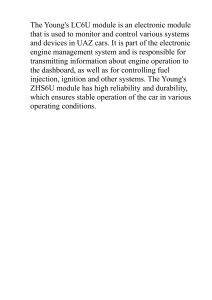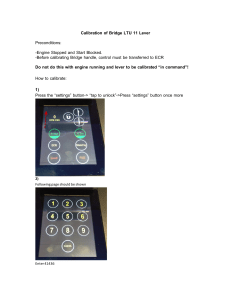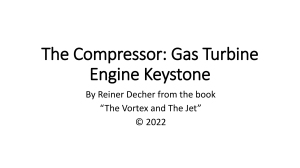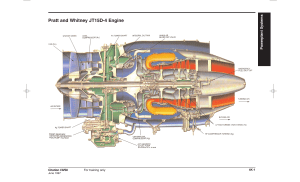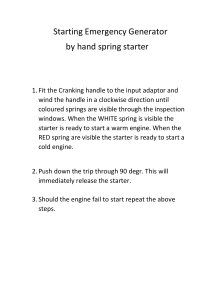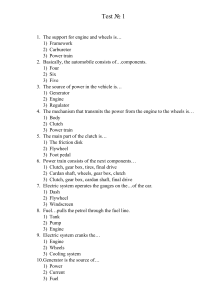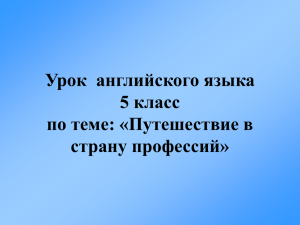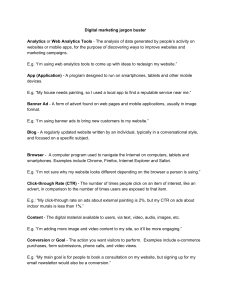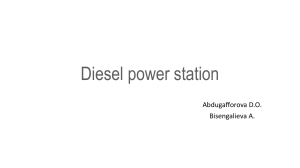
Manual Hydraulic Engine Remote Controls
Installation Instructions
Owners Manual
MB-150103-0E
PREFACE
Thank you for purchasing MAROL manual Hydraulic Engine Remote Control System.
The MRS System has the following features as compared to conventional mechanical and wire cable
engine remote controls:
Due to the nature of the oil hydraulic system, the system offers:
1. Smooth and light operation, especially for multiple station installations.
2. Flexibility in the routing of hydraulic tubes.
3. A longer service life since most of the parts are hydraulically sealed and most mechanical parts
are not subject to corrosion or stiffness.
4. Smoothness and lightness in operation does not change over years of use.
CAUTION: Without proper installation, operation and maintenance, however, the system cannot offer
the above features and may cause malfunctions which may result in a possible accident.
Before proceeding to the installation and operation, please read the instruction thoroughly and
understand the full details of the installation and the functions.
WARNING
THE MRS SYSTEM IS DESIGNED FOR ENGINES WHICH HAVE THE SHIFT AND THROTTLE LEVER
OPERATING TORQUE OF UNDER 686N–cm (70Kgf-cm).
BEFORE STARTING THE ENGINE, THE FOLLOWING INSPECTION AND OPERATION SHOULD BE
PERFORMED. (For details, refer to chapter 8. OPERATIONAL PRECAUTIONS)
1.
2.
Accumulating pressure of the Charge Tank Unit ACV-100.
Operate the Control Head full strokes back and forth several times and confirm that the handle
positions of the Control Head match the Throttle Shift lever positions accordingly.
3.
Set the Control Head so that its Shift Handle is at Neutral and Throttle Handle is at Idle before
starting the engine.
WITHOUT ABOVE INSPECTION AND OPERATION, MISOPERATION MAY OCCUR UPON STARTING THE
ENGINE DUE TO MISMATCHING OF LEVER POSITIONS.
NOTE:•@Please keep this instruction manual on hand.
Table of Contents
1. SPECIFICATIONS ____________________________________ 2
2. SYSTEM COMPONENTS ______________________________ 3
3. HYDRAULIC TUBING DIAGRAMS
3-1. Single Engine, One Station ____________________ 4
3-2. Single Engine, Two Station ____________________ 5
3-3. Single Engine, Three Station ___________________ 6
3-4. Twin Engine, One Station _____________________ 7
3-5. Twin Engine, Two Station _____________________ 8
3-6. Twin Engine, Three Station ____________________ 9
4. COMPONENT INSTALLATION
4-1. Control Head ______________________________ 10
4-2. Receivers __________________________________ 12
4-3. Charge Tank Unit ___________________________ 14
5. PIPING ___________________________________________ 16
6. OIL FILLING / AIR PURGING __________________________ 20
7. ADJUSTMENT _____________________________________ 23
8. OPERATIONAL PRECAUTIONS ________________________ 26
9. TROUBLESHOOTING ________________________________ 28
10. DIMENSIONAL DRAWINGS OF COMPONENTS
10-1. Control Head _____________________________ 30
10-2. Shift Receiver _____________________________ 31
10-3. Throttle Receiver __________________________ 32
10-4. Charge Tank Unit __________________________ 33
Attachment: Template for Control Head
1
1.SPECIFICATIONS
NAME
CONTROL HEAD
SHIFT RECIVER
THROT TLE
RECEIVER
MODEL
CH-22A
MMR-22S
MMR-22T
CYLINDER DIAMETER
φ22mm
EFFECTIVE STROKE
23mm
EFFECTIVE WORKING
ANGLE
90 degree
MAXIMUM WORKING
ANGLE
110 degree
100 degree
DISPLACEMENT
8.7cm3
TRANSMIT TING
TORQUE
12N-m (1.22f-m)
SYSTEM PRESSURE
(NOTE 1)
2.8MPa (28.4kgf/cm2)
CABLE ADJUST
STROKE
18 - 56 mm
(NOTE 2)
WEIGHT
2.7 kg
35 ‑ 1 1 2 m m
(NOTE 3)
2.0 kg
(NOTE 1) Generating pressure is at 12N.m {1.22kgf.m}, and the control handle operating angle of 45
(NOTE 2 ) Cable stroke from Neutral to Forward (Reverse).
(NOTE 3) Cable stroke from Idle to Full
NAME
CHARGE TANK UNIT
MODEL
ACV-100
ACCUMLATING PRESSURE
0.6 MPa {6 kgf/cm2}
EFFEC TIVE ACCUMLATOR OIL
QUANTIT Y
105 cm3
SAFET Y VALVE SET TING
PRESSURE
3.4MPa {35kgf / cm2}
RESERVOIR CAPACIT Y
500 cm3
WEIGHT
5 kg
2
2. SYSTEM COMPONENTS
NAME
SINGLE
ENGINE
MODEL
T WIN
ENGINE
SS1 SS2 SS3 WS1 WS2 WS3
CONTROL
HEAD
CH-22A
1
2
3
2
4
6
HEAD COVER
HC-CH-22
1
2
3
2
4
6
SHIFT RECIVER
MMR-22S
1
1
1
2
2
2
THROT TLE
RECIVER
MMR-22T
1
1
1
2
2
2
CHARGE TANK
UNIT
ACV-100
1
1
1
2
2
2
DECAL
for
CONTROL HEAD
1
2
3
2
4
6
Nylon Tube
TH04 50m
1
1
2
2
2
3
STANDARD
TUBING
(NYLON)
AIR PURGE
VINYL TUBE
Connector
20CC334XX
Installed prior to shipment
Union Tee
20364-U1/4
2
2
2
4
4
4
1m Transparent
1
1
1
1
1
1
12 16 20
SET SET SET
24
SET
32
SET
40
SET
MOUNTING BOLT SET
(NOTE 2)
NOTE: 1 The numbers after SS and WS denote the number of control station.
NOTE: 2 Mounting Bolts (Stainless steel) of M8, nuts, plain and spring washers
are not included in the system kit and should be provided by the
customers
3
3. HYDRAULIC TUBING DIAGRAMS
All the diagrams denote the shift cable Pull – Forward, the throttle cable Pull – Acceleration.
Refer to Chapter 5. Piping (page 16) for other application.
3-1.SINGLE ENGINE / SINGLE STATION
Model : MRS-SS1
4
3-2.SINGLE ENGINE / TWIN STATION
Model : MRS-SS2
5
3-3. SINGLE ENGINE / TRIPLE STATION
Model : MRS-SS3
6
3-4. TWIN ENGINE / SINGLE STATION
Model : MRS-WS1
7
3-5. TWIN ENGINE / TWIN STATION
Model : MRS-WS2
8
3-6. TWIN ENGINE / TRIPLE STATION
Model : MRS-WS3
9
4. COMPONENT I NSTALLATION
The following tools and parts will be necessary for the installation, piping, oil filling/air purging
and adjustments:
1.Spanners (8mm, 10mm, 12mm, 13mm, 14mm)
2.Allen Wrench (3mm, 4mm, 5mm)
3.Drill (9mm)
4.Jig Saw
5.Stainless steel mounting bolts, nuts, plain washers, spring washers.
(Refer also to Chapter 2. SYSTEM COMPONENTS)
4-1 CONTROL HEAD
4-1-1. D
ecide IInstalla
nstalla
tion LLoca
oca
tion
Decide
nstallation
ocation
Decide the installation location of the control head considering the following points.
1. Should be installed at rigid part of the structure to withstand the operation of the
handles.
2. At least 25mm of clearances are necessary for both sides of the handle to remove the cover
and adjust the handle positions.
3. Maximum handle working angle is 100. Interference should be checked for its working
radius.
4. The Control Head should be installed within 60 vertical from the horizontal plane and within
5 slant sideways.
10
4-1-2 Drilling the Mounting Holes
When the installation location is decided, proceed for drilling as follows:
1. By using the template attached to this instruction manual, mark the 4 installation bolt
holes and 4 corner holes for the square cut away portion.
2. Drill the 8 holes marked above.
3. Cut away the square portion by using a jig saw
4-1-3 Control Head Installation
Installation bolts, nuts, washers are not included in the system kit since the thickness of the
dash varies. Please provide suitable length of M8 bolts, nuts, plain and spring washers.
Stainless steel (SUS304) is recommended.
1.
Bring the Control Head in place and affix it to the dash by using the bolts, plain washers,
spring washers and nuts. See the figure below.
Caution: Air Purge Valves should face the vessel’s bow direction.
The Spacer (black rubber seal between the cover and the handle) should
be placed straight as shown in the figure below.
2.
3.
In order to avoid dirt getting into the system, the rubber caps on the pipe fittings should
be kept on until ready for piping work.
The cover for the control head is packed separately in the system kit. It should be
assembled after finishing the oil filling / air purging and adjustment procedures.
11
4-2Receivers
4-2-1. Decide Installation Location
Please note the following points:
1. The receivers are so designed that they are connected to the short length of wire pushpull cables from the engine. Select an appropriate location where:
a) Distance from the engine throttle and shift lever is as short as possible and away
from the engine heat or other conditions hazardous to the tubing, such as
vibrations.
b) Install the receivers at rigid part of the vessel structure. Reinforce the mounting
part if necessary.
2. The maximum lever working angle is 100 degree (effective working angle is 90 degree).
Look for interference of lever movement. If the lever movement is limited, it may
become a source of malfunction.
3. Although the receivers can either be mounted on floor or on the wall, the units should
be installed so that they face either horizontal or straight vertical and air purge valves
face up or positioned high.
4. As mentioned in 1, push-pull cables are used in the connection of the receiver units to
the engine levers. The locations must be selected so that route of push-pull able is as
straight and as short as possible.
If push-pull cables are routed tightly and too long, the system may fail to offer smooth
and light operation.
12
4-2-2. Drilling the Mounting Holes
When the installation location is decided, proceed for drilling as follows:
1. Refer to Page 31 – Page 32 dimensional drawings, mark the 2 installation bolt holes.
2. Drill the 2 holes (9mm diameter) marked the above.
4-2-3. Installation of Receivers
Installation bolts (M8), nuts, washers are not included in the system kit since the thickness
of the mounting location varies. Please provide suitable length of M8 bolts, nuts, plain
and spring washers. Stainless steel (SUS304) is recommended.
1.
2.
The receivers are installed by using 2 M8 bolts either on the floor (horizontal plane) or on
the wall (straight vertical).
In order to avoid getting dirt into the system, the rubber caps on the pipe fittings should
3.
be kept on until ready for piping work.
Do not connect the wire push-pull cables at this point in time.
13
4-3. Charge Tank Unit
4-3-1. Decide Installation Location
Please note the following points.
1. Select a rigid part of the vessel’s structure and reinforce the mounting members if
necessary.
2. Avoid any location where there is any strong vibration and high heat.
3. Install the unit horizontally and facing the oil filling port up.
4. It is necessary to operate the handle to accumulate the pressure. Leave enough
space for handle operation. The handle direction can be changed by reassembling
the body to its mounting base as shown in the figure below.
5. As daily maintenance, inspection, and accumulating operation are required, the
unit should be installed at a location convenient for such an inspection and
operation.
6. Although a relief valve is installed in the unit for the pressure rise caused by thermal
expansion of hydraulic oil, the unit should be installed away from direct sunlight and
frequent heat influences.
14
4-3-2. Drilling the Mounting Holes
When the installation location is decided, proceed for drilling as follows:
1. Refer to Page 33 dimensional drawings, mark the 4 installation bolt holes.
2. Drill the 4 holes (9mm diameter) marked the above.
4-3-3 Installation of Charge Tank Unit
Installation bolts (M8), nuts, washers are not included in the system kit since the thickness
of the mounting location varies. Please provide suitable length of M8 bolts, nuts, plain
and spring washers. Stainless steel (SUS304) is recommended.
1.
Install the Mounting base separately supplied with the unit on the wall by using 4 bolt
sets (not supplied with the unit).
2. Assemble the body to the mounting base using the 4 bolt set included in the system kit.
At this stage, the direction of the operating handle is decided.
In order to avoid getting dirt into the system, the rubber caps of the pipe fittings should be
kept on until ready for piping work.
15
5.PIPING
WARNING: FOR HYDRAULIC SYSTEM, DIRT AND FOREIGN MATERIAL CAUSE
MALFUNCTION OF THE SYSTEM. PAY UTMOST ATTENTION TO PREVENT DIRT
OR FOREIGN MATERIAL FROM GETTING INTO THE SYSTEM.
5-1. TUBE SELECTION
1.
There are two types of piping material available: Nylon tubes and copper tubes. We
recommend nylon tubes.
A. Nylon Tube (Standard Supply)
Tube Specification: Bridgestone TH-04
(6.35mm O.D., 1.02mm Wall Thickness)
Total Piping Length Allowed: Under 30m/one line
Ambient Temperature: - 15C ~ +80C
B.Copper Tube (Optional)
Tube Specification: JIS H3300 C1220T
(6mm O.D., 1mm Wall Thickness)
Total Piping Length Allowed: Under 50m/one line
Ambient Temperature:- 15C ~ +80C
NOTE: Allowable total piping length is noted as “one line” which is, for example, the total
piping length of the shift line of the port engine shift. The total piping length should be
less than 30 meters per line.
2.
Nylon tube offers easier routing work but it tends to expand due to the internal oil
pressure.
CAUTION: When the operating pressure is high (the levers of engine are heavy to
operate), the receiver may not move full strokes and the Phase Adjust Function
does not work due to the tube expansion. When this condition becomes evident,
copper tubing should be used partially or exclusively even though the total routing
is short.
Transmitting torque should be less than 686N-cm(70 kgf-cm)
5-2. CONFIRM PORT CONNECTION
Check the port connection (A and B ports).
NOTE: See extra page to the Shift Receiver as its port connection differs according to the
engine lever specification. (see extra page)
1. The control head has fixed port connection: B port for the cylinder cover and A port for
the other.
2. Two ports of the Charge Tank Unit are both A ports.
3. The Throttle Receiver may require interchanging the mounting base, but its port
connection is fixed so that B port is at the pilot check valve.
4. Port connection differs for the shift receiver according to the engine lever working
direction. The piping ports change is shown in the chart and figures on the next page.
16
Depending on the engine specification, the direction of the push/pull throttle may cause
the engine to accelerate or reverse. A port and B port will be determined according to
the engine specifications. Please check first with the engine specification to determine
the direction of the throttle.
SHIFT
RECEIVER
SHIFT PULL-FORWARD
Shift Receiver's Cylinder
Cover B port
SHIFT PUSH-FORWARD
Shift Receiver's Cylinder
Cover A port
THROT TLE PULLACCELERATION
THROT TLE
RECEIVER
THROT TLE PUSHACCELERATION
17
THROT TLE Receiver's
Cylinder Cover B port
THROT TLE Receiver's
Cylinder Cover A port
5-3 LAYING TUBING
Referring to Chapter 3: HYDRAULIC DIAGRAM (page 4~9), the tubes are laid in the vessel.
The connection between the control head and receivers is from A port to A port (from B
port to B port). The connection between two control head is from A port to B port (B port
to A port).
1.
2.
3.
4.
5.
6.
In order to avoid getting dirt into the system, the end of tubes should be covered by a cap
or plugged by tapes.
When routing tubes, lay the tube as straight as possible and do not bend it vertically as
shown in the figure. It allows air to stay in the bent part and becomes the cause of
irresponsive control. It is recommended to mark the tube with port mark to avoid
misconnection.
Avoid routing around locations where high heat is expected.
Minimum bending radius is 50mm. When bending copper tubes, use a pipe bender of
proper size. Do not squash the tube.
When cutting nylon tube, use a sharp knife or a tube cutter and cut the end squarely.
When cutting copper tube, use a pipe cutter and cut the end squarely.
Do not use a saw as it creates saw dust and notches on the cut end which causes
system malfunction.
When routing of tubes is finished, remove the end cap of tubes and flush the tube with
compressed air.
18
5-4 PIPING CONNECTION
Connection of tubes to the connectors is then performed. Compression fittings are used for
both nylon and copper tubes and the connecting manner is the same for both tubes.
1. Put the nut and sleeve to the tube in this sequence. Look for the direction of the nut and
sleeve.
2. Insert the tube into the fitting until the tube is pushed against the bottom of the fitting.
3. While pressing the tube against the bottom of the fitting, tighten the nut with a spanner.
When heaviness is felt, that is the point where the sleeve is biting the wall of the tube.
Tighten the nut further for 1.25 to 1.5 turns.
5-5 FINISH
1.
2.
When piping layout and tightening of fittings are finished, fix the tubes to the vessel’s
structure securely using pipe clamps which are included in the system kit.
If there are not enough clamps, provide suitable clamps.
Nylon tubes should be protected by a spiral tube where necessary.
19
6. OIL FILLING/AIR PURGING
1. PREPARATION
Before starting oil filling/air purging process, confirm:
1. The levers of control head and receivers move full stroke; do not install the control head
where it may be blocked or come in contact with any object.
2. The tightness of pipe fittings and air bleeders.
2. OIL FILLING
Specified hydraulic fluid is BARREL #3 (Red)
Please do not use steering fluid oil and brake oil.
1.
Remove the filler cap of the charge tank unit and fill the specified oil in the reservoir.
NOTE: Do not allow dirt to get into the reservoir.
3. AIR PURGE AT RECEIVERS
1.
2.
3.
Air purge is done from the unit close to the charge tank unit. Thus, air purge is done from
the receivers. Now, start from the shift receiver.
Move the lever of the shift receiver to the stroke end of the reverse position.
Accumulate the pressure of the charge tank unit by
operating its handle slowly.
NOTE: Do not operate the handle too fast as it
may cause cavitation and air may be displaced
into the lines. Operate the handle slowly at
speed of 1 second per push or pull stroke.
4.
According to the handle operation, the pressure gauge
shows the rise of the pressure. When its indicating needle
reaches the blue marked area, accumulation is finished. ( As a
relief valve is assembled, the pressure does not increase over the blue marked area).
NOTE: If the pressure does not rise or drop instantly, oil is leaking
through loose fittings or loose air purge valves.
20
5.
As the handle of the charge tank unit is operated and oil is displaced into the lines, oil
level of the reservoir drops. Add oil when the oil level drops near the “E” (empty) mark.
(About 30 to 40 strokes of the handle operation make the oil level drop to the “E” level).
NOTE: Look for the oil levels as air will be taken into the lines if the oil level
drops below the “E” mark. If air is taken in, air purging must be done again
from the beginning.
6.
7.
8.
9.
Put one end of the attached transparent vinyl tube
over the air bleeder and put the other end to a clean
empty oil container.
Oil which comes out of the air purge valve can be used
again if it is received by a clean container. But, it is
recommended to filtrate with a filter of 20
WARNING: IF OIL IS CONTAMINATED BY DIRT, IT
MAY CAUSE MALFUNCTION OF THE SYSTEM.
Loosen the air purge valve (counter clock wise for 0.5
to 1 turn). NOTE: Be careful because in large
quantities of compressed air and oil gush out.
When oil does not comes out, tighten the air purge
valve and accumulate the pressure of the charge tank
unit and repeat step 8.
NOTE: Do not tighten the air purge valve too
strongly. (Tightening torque is 2.9N-m)
10. While performing oil filling/air purging, the levers of
control head and the receivers move. This is not
abnormal. A neutral detent is assembled for the shift
receiver. Make sure that the lever is not limited by this
detent. Move the lever to the reverse stroke end by
hand if it has stopped at the neutral detent.
11 It is faster and more effective to perform oil filling/air purging with two persons, one
operating the charge tank unit and other purging air, because air purging is done with
higher pressure and faster oil flow.
12 Tighten the air purge valve when clear oil without air bubbles flows out continuously
from the air purge valve. Leave it for about one minute and loosen the air purge valve
again to see if clear oil without air bubbles comes out. If no air is observed, oil filling/air
purging of this line (Shift) is finished. Tighten the air purge valve.
In the same manner mentioned in steps 1 through 12, oil filling/air purging should be
carried out for the throttle lines. As there is no neutral detent for the throttle receiver, it is
not necessary to move the lever to its stroke end.
21
6-4 AIR PURGE AT CONTROL HEAD
1.
After finishing the receivers, air purging is performed for the control head. In the multiple
station controls, air purging should be performed first for the control head, which is
closer to the charge tank unit. The numbers in the figure ( ) shows the sequence of air
purging process.
2.. The manner and process of air purging are the same as mentioned in the proceeding
Section 6-3.
3. While performing oil filling / air purging, oil flow from the air purge plug at the highest
control head (3) or (4) may become weak compared to air purge at receivers, this is
because there are many bypass valves which operation oil passes, and is not abnormal.
6-5 CONFIRM
ATION
ONFIRMA
1.
2.
When air purging is finished for all the
components, confirm the movement of the
receivers and the control heads by operating
the control handle.
If the direction of receiver is opposite,
interchange the two piping lines.
WARNING: Before interchanging the piping, be sure that the pressure is
dropped by loosening the air purge valve (Check with the pressure gauge).
Otherwise, compressed oil will gush out when the fitting is loosened.
3.
When the movement is confirmed, accumulate the pressure of the charge tank unit and
confirm again whether air purging is complete by loosening each air purge valve and
checking for clear oil without air bubbles.
6-6 FINISH
1.
After confirming the above, accumulate the pressure of the charge tank unit, fill oil in the
reservoir up to the “F” (full) mark and close the filler cap.
22
7. ADJUSTMENT
WARNING: ADJUSTMENT SHOULD BE PERFORMED WITHOUT RUNNING THE
ENGINE
7-1. ADJUSTMENT OF CONTROL HEAD
The control handles can be adjusted for +-30 to neutralize the position of handles and to
avoid interference of the levers around dashboard. Moreover, the control handles can be
adjusted +- 5 in order to align a handle position on either side.
1.
Loosen the bolts (4 each), adjust the neutral position or the handle position and tighten
the bolts. Tightening torque is 4.9N-m {0.5kgf-m}.
WARNING: Pay extra attention to the tightness of the bolts and watch that
the tightening face does not get wet with oil. Loose handles may cause
system malfunction and a possible accident.
7-2. INSTALLATION OF HEAD COVER, HANDLE CAP AND NAME PLATE
1.
2.
3.
Remove the bolts (4 each) from the mounting base of the control head, put the head
cover over the mounting base. Be sure that the guide flange of the head cover is slid into
the groove of the spacer. Tightening torque is 2.9N-m {0.3kgf-m}.
Put the handle cap to the handle boss by pressing the cap. Twist and pull when removing
the cap.
Attach the name plate on the head cover. Note type of the shift and throttle.
23
7-3.
ADJUSTMENT OF SHIFT RECEIVER
The positions of the control head handles and the receiver levers may become mismatched due to
a very slight internal oil leak during operation and/or due to ambient temperature changes over a
long period of mooring. To adjust this mismatching of the handles and the levers, a by passing
function is provided at each stroke end of the cylinders of the control heads and the receivers.
Phase between the control head handles and the receiver lever is adjusted automatically by
operating the control head full strokes back and forth.
During normal operation, phase is adjusted automatically.
In order to work an automatic phase adjustment
function effectively, it is necessary to operate the
receivers levers at an effective working angle (90 ).
1.
Move the shift lever to the neutral position at its
neutral detent.
2. Measure the stroke “S” (Neutral to Forward and
Neutral to Reverse) of the shift cable of the engine.
Then, set the shift lever of the engine at its neutral
position.
Forward (Reverse) Neutral Reverse (Forward)
MEASURE STROKE “S”
3. Adjust the red indicating needle of washer attached
to the lever to this “S” position and tighten it securely.
Tightening torque is 4.9N-m {0.5kgf-m}.
For example, S=30mm
4. Connect the shift cable to the ball joint. Screw for the
ball joint M5
5. After confirming the shift lever and the engine shift
lever at its neutral position, fix the shift cable to the
shift receiver. Tightening torque is 2.9N-m {0.3kgf-m}.
Remove the support plate from the base and fix the
shift cable to the support plate by using the shim,
cable clamp.
Do not bend sharply.
6.
GUIDE, COVER, BOLT, GROOVE, SPACER, NAME
PLATES, SHIFT, THROTTLE
Remove the bolts, Put the head cover over the
mounting base, The guide flange of the head cover is
slid into the groove of the spacer.
It is important to confirm the actual positioning of
neutral, forward and reverse of the shift gear by
operating the control head.
Confirm the effective working angle 90, if the receiver does not move full strokes, phase adjust
function at stroke ends will not work and the handle position becomes mismatched to the lever of
24
the shift gear. The effective working angle of the shift receiver lever should be the same whether
it is free or the cable connected. Check the working angles of the shift receiver lever with and
without the ball joint of the shift cable connected. If the positioning is not quite satisfactory,
adjust the installation position of the washer.
Not enough stroke Make to move outside
Over stroke
Make to move inside
WARNING: IF THE RECEIVER DOES NOT MOVE FULL STROKES, PHASE ADJUST
FUNCTION AT STROKE ENDS WILL NOT WORK AND THE HANDLE POSITION
BECOMES MISMATCHED TO THE LEVER OF THE SHIFT GEAR ( REFER TO
CHAPTER 8: OPERATIONAL PRECAUTIONS)
If the washer in one slot of the shift receiver lever is moved, in about 1.2mm
stroke will fluctuate.
ADJUSTMENT OF THROTTLE RECEIVER
7-3.
1.
Set the throttle receiver lever at the idling position.
NOTE: The throttle receiver lever is only activated
by a hydraulic system.
2.
Measure the stroke of the engine throttle from idle to full
throttle. After measuring the stroke, set the engine throttle
lever at the idle position.
Full Throttle (Idling) Idling (Full Throttle)
Measure the stroke “T” For example, at “T” = 60mm•@
3.
Fix the washer to the lever scale “T”, connect the throttle cable
to the throttle receiver in the same manner mentioned in the
shift receiver.
4.
Confirm the actual positioning of idle and full throttle of the
engine throttle by operating the control head. If the
positioning is not quite satisfactory, adjust the length “T” of
the washer position. Check the working angles of the shift receiver lever with and without
the ball joint of the shift cable connected.
If the positioning is not quite satisfactory, adjust the installation position of the washer. If
the lever length of the throttle receiver is changed, positioning of
Idle will also change. Readjust cable clamp position accordingly.
If the washer in one slot of the shift receiver lever is moved, in about 2.5mm
stroke will fluctuate.
25
8. OPERATIONAL PRECAUTIONS
8-1. PHASE ADJUSTMENT FUNCTION
1.
2.
3.
The positions of the control head handles and the receiver levers may become
mismatched due to a very slight internal oil leak during operation and/or due to a very
slight internal oil leak during operation and/or due to ambient temperature changes over
a long period of mooring. To adjust this mismatching of the handles and the levers, a
bypassing function is provided at each stroke end of the cylinders of the control heads
and the receivers.
Phase between the control head handles and the receiver levers is adjusted
automatically by operating the control head full strokes back and forth.
During normal operation, phase is adjusted automatically.
WARNING: IF THE RECEIVER DOES NOT MOVE FULL STROKES, PHASE ADJUST
FUNCTION AT STROKE ENDS WILL NOT WORK AND THE HANDLE POSITION
BECOMES MISMATCHED TO THE LEVER OF THE SHIFT GEAR ( REFER TO
CHAPTER 7: ADJUSTMENT OF SHIFT RECEIVER)
8-2. CHARGE TANK UNIT
The MRS manual hydraulic engine remote control system is operated under accumulated oil
pressure of 0.34 ~ 0.64 Mpa {3.5~6.5kgf/cm2} via charge tank unit.
The pressure is accumulated by the charge tank unit and its pressure is confirmed by the
pressure gauge.
1. Check whether the indicating needle of the pressure gauge is in the range of the blue
marked area.
2. If the needle is not in the blue marked area, operate the handle to accumulate. Be sure to
check the oil level.
3. If the oil level is below the “E” mark, fill the specified hydraulic fluid “BARREL #3
(Red Color)” before pumping.
NOTE: Pumping when the oil level is below “E” lets air pumped into the
system.
This will cause malfunction of the system and air purging must be done
thoroughly again.
4.
With frequent ambient temperature changes, the accumulated pressure may drop. If the
pressure drops frequently and oil level decreases, an external oil leak is suspected. Check
for loose air purge valves.
26
8-3. INSPECTION BEFORE SAILING
Before each sailing and prior to starting the engine, check the functions of the system by the
following inspection and operation.
WARNING: STARTING THE ENGINE WITHOUT CHECKING THE FUNCTION MAY RESULT IN A
SERIOUS ACCIDENT.
1.
2.
Check the accumulated pressure of the charge tank
unit. Check whether the indicating needle of the
pressure gauge is in the range of the blue marked
area.
Perform the phase adjust operation by moving the
shift and throttle control handles full strokes back
2〜3度ハンドルをフルストローク作動させる。
and forth several times. Check whether the
positions of the engine gear and throttle match the
positions of the shift and throttle receivers. For the
multiple station controls, this operation can be
done by one of the control heads. Other stations
will be automatically adjusted.
WARNING: BEFORE EACH SAILING AND PRIOR TO STARTING ENGINE, CONFIRM
THE ACCUMULATED PRESSURE AND PHASE ADJUSTMENT
8-4. MAINTENANCE AND INSPECTION
The following items should be inspected periodically to find any abnormalities and to keep
the system free from trouble.
INSPECTION PERIOD
INSPECTION POINTS
1 MONTH
3 MONTH
6 MONTH
1 YEAR
LOOSE INSTALLATION
At each components
At each pipe fitting
At each air purge valve
At connection of cable to ball joint
○
○
○
○
GREASE THE BALL JOINT
○
○
○
STROKE ADJUSTMENT
○
○
○
PUSH-PULL CABLE
○
○
○
27
9.TROUBLESHOOTING
WARNING: When performing overhaul, be sure that the pressure is dropped by
loosening the air purge valve (Check with the pressure gauge).
Otherwise, compressed oil will gush out when the fitting is loosened. After
performing overhaul, air purging and adjustment must be done thoroughly.
PHENOMENON
When purging air, oil
does not flow out of
the air purge valve or
oil flow is slow.
Phase adjust function
does not work.
Operation of control
handle is extremely
heavy.
Engine throttle drops
and control handle is
moved back to idle.
Engine throttle drops
and control handle
does not come back
to the idle position.
Two handles of
control head do not
match.
PROBABLE CAUSE
COUNTERMEASURE
PAGE
Air purge valve is not loose
enough.
Loosen air purge valve. (0.5 ~
1 turn counter-clockwise)
20
Handles or levers do not
move full strokes due to
interference in installation.
Remove the cause.
10
20
Shift lever is stopped at the
neutral detent.
Move the lever to reverse
position by hand.
20
Hydraulic piping is plugged,
kinked or smashed.
Repair or replace.
18
Hydraulic oil is not suitable.
Viscosity is high.
Change to the specified oil.
20
Due to misalignment, the
levers of receivers do not
work full strokes.
Adjust the position of ball
joint.
24
Handles or levers do not
move full strokes due to
interference in installation.
Remove the cause.
10
20
Hydraulic oil is not suitable.
Change to the specified oil.
20
Operating torque of the
engine shift gear or throttle
lever is too heavy.
Check and repair.
Check also the required
torque.
Pilot check valve of throttle
receiver is damaged at its
seal.
Disassemble pilot check valve
and repair or replace the seal.
Pilot piston of throttle
receiver is not working right.
Disassemble pilot check valve
and repair or replace the
piston.
External leakage of oil
Check and repair piping.
Check fittings.
Seal of receiver piston may be
Replace the seal.
damaged.
Wrong adjustment of the
handle position
28
Readjust
23
PHENOMENON
Receiver does not
move exactly with the
movement of control
head.
Handle position
becomes mismatched.
Handle is moved back
when freed.
Operating one control
head does not make
other control head
move simultaneously
or the handle position
becomes mismatched.
PROBABLE CAUSE
COUNTERMEASURE
PAGE
Air purging is not
complete.
Purge air again.
20
Accumulated pressure is
low.
Check pressure gauge.
26
Piping distance of nylon
tube is too long.
Change nylon tubing to
copper tubing.
Recommended piping
distance is 30m one line.
16
Operating torque of the
Check required torque.
engine shift gear or throttle
Change to copper tubing.
is too heavy.
Ball joint position of the
lever is not adjusted right.
Readjust.•B
External oil leakage
Check and repair piping.
Check fittings.
Loose installation at lever
of receiver to the wire
cable
Check, retighten and
readjust.
Seal of bypass valve is
damaged.
Disassemble pilot check
valve and wash or replace
the parts.
Seal of bypass valve of the
control head which does
not move or becomes
mismatched is damaged.
Disassemble pilot check
valve and wash or replace
the parts.
16
24
NOTE: Handle denotes the handle of control head and lever denotes the lever of the
receiver.
29
10.
DIMENTIONAL DRAWINGS OF COMPONENTS
10.DIMENTIONAL
10-1. CONTROL HEAD
30
10-2. SHIFT RECIVER
31
10-3. THROTTLE RECIVER
32
10-4. CHARGE TANK UNIT
33
MEMO
34
MAROL CO., LTD.
2-1-34, Ohashi-cyo, Nagata-ku,
Kobe, Japan 6530037
http://www.marol.co.jp/
